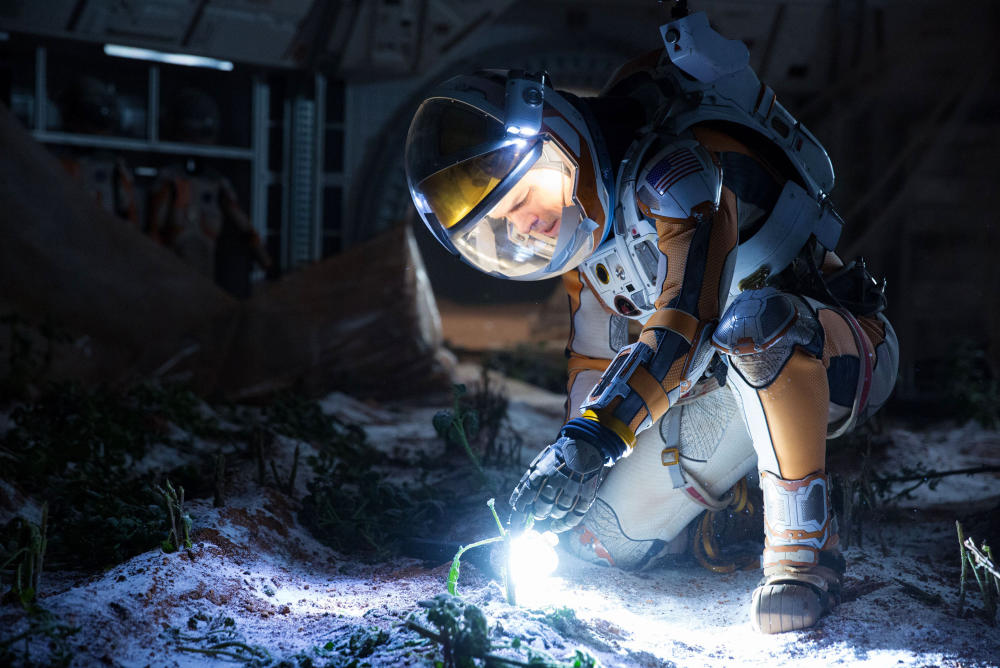If you watch the film The Martian, you’ll see Hollywood explosions and special effects galore, but you’ll also see some serious science.
Actor Matt Damon, who plays stranded astronaut Mark Watney, must calculate his way through food shortages, Martian road trips and other misadventures as he fights to find a way off the red planet.
Numbers are a matter of life and death for Damon’s astronaut, and in this movie they’re not pulled from thin air.
“If you care to double-check the results from what you see in the film, then you’ll find out it’s accurate,” says Andy Weir, who wrote the book on which the film is based.
The book began as a thought experiment by Weir, who is a longtime computer programmer. He began by imagining what a real mission to Mars might be like, and the potential problems the astronauts would need to plan for.
“I finally thought, ‘Huh. This actually might make for a pretty interesting story,’ ” he says.
Weir approached his plot with the meticulous thinking of an engineer. He quickly determined that the main problem for a stranded astronaut would be food.
“We have the technology to turn carbon dioxide back into oxygen; we have the technology to take sewage and turn it back into drinkable water,” Weir says. “But we don’t have a technology to easily generate food. The only way to make food is to grow it.”
There are no quick Hollywood fixes to the challenges faced by the astronaut castaway. He can grow potatoes the crew brought along, but he needs soil. The dirt he brings in from Mars is sterile, so he has to find fertilizer (there’s only one source on Mars: himself). Then he finds a new problem: The mission brought enough water to drink, but not enough to grow crops.
Each need is based on actual calculations done by Weir. And his solutions are based in scientific fact: “My primary research tool was Google,” says Weir, who used the search engine to dig up research papers and old Mars mission designs.
The novel first appeared on Weir’s website — where he guesses the first draft was read by about 3,000, or so, hardcore fans. These readers loved all the detail.
“These are nerds like me,” he says. “These are my people. And so I was writing something for them; I was writing a story where I show my work.”
Weir’s supernerd readers pushed his realism even further. Whenever he made a mistake, they let him know. And because the book was initially posted online, he could easily rewrite it to make it right.
How accurate is the resulting novel?
“The Martian has almost all of its technical details correct,” says Robert Zubrin, the head of The Mars Society, which advocates sending people to explore the red planet. Zubrin, who has written nonfiction and fiction books about going to Mars, points out there have been many other accurate books written missions to Mars. What makes the Martian special he says, is its simple man versus nature plot. “It’s about one person, one human mind, one human heart,” he says.
And even this story isn’t perfect, adds Suzanne Smrekar, a planetary scientist NASA’s Jet Propulsion Laboratory, who is helping to put together a robotic mission to the red planet. She spotted a hole in the film’s plot right away: The astronaut is stranded on Mars by a powerful dust storm that separates him from his crew.
“The atmosphere of Mars is one one-hundredth the density of our own atmosphere, so it really cannot provide much of a force,” she says. “That’s the one big artistic license of the whole book.”
Author Andy Weir told Weekend All Things Considered that he knew dust storms on Mars wouldn’t be that fierce, but he wanted a thrilling way to start his novel — so he allowed himself some literary leeway. After all, it is science fiction.
9(MDA3MTA1NDEyMDEyOTkyNTU3NzQ2ZGYwZg004))
